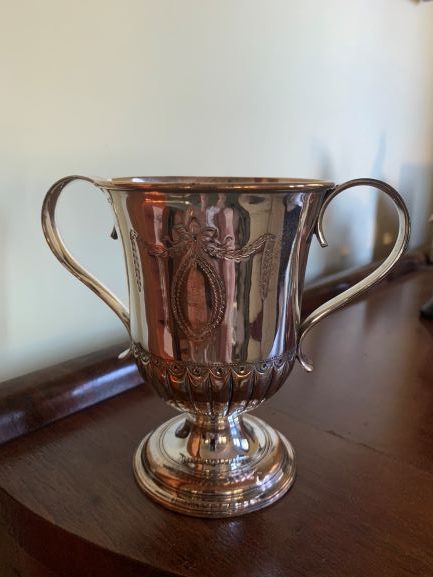This is not a silver loving cup.
When it was made by Thomas Law & Co. sometime between 1785 and 1807, neoclassicism was all the rage in English architecture, interior design, and “stylish” consumer goods, thanks largely to the efforts of Robert Adam, who almost single-handedly launched the classical urn into English domestic spaces. The Greco-Roman influences so popular at the time can be seen in this example’s symmetrical restraint, swags, fluting, and shape. The urn was a very handy form for all manner of decorative objects, and we see it ubiquitously today in planters and vases and trophies, sometimes called loving cups. The two-handled loving cup, based on an ancient ritual of communal drinking, was a natural for marking achievements and expressing appreciation. By the 18th century, the “cup” aspect of the object had become largely metaphorical and the handles vestigial. It was no longer a cup per se, but a symbol. When applied to such a thing, Adam’s neoclassical motifs and (perhaps most importantly) the engravable surfaces they accommodated were perfectly suited to special occasions. So if this is not a silver loving cup, what is it?
It is a relic of manufacturing innovation.
Although it looks to be silver, it is actually made of a copper/sterling fusi on called Old Sheffield Plate (OSP), developed in Sheffield, England, in the 1740s. A core of copper is sandwiched between very thin sheets of sterling silver and then fired to fuse the metals into a product that looks and behaves just like sterling silver but actually contains only a fraction of the precious metal. Using sheets of this fused metal, silversmiths in Sheffield and Birmingham could create virtually any article that could be made in sterling silver. When new, the difference was undetectable, but the sterling skin could be worn away by engraving, damage, or even vigorous cleaning over time, as in this example, exposing the copper underneath. Fused silver plating like this was superseded entirely in the 1830s by electroplating technology.
on called Old Sheffield Plate (OSP), developed in Sheffield, England, in the 1740s. A core of copper is sandwiched between very thin sheets of sterling silver and then fired to fuse the metals into a product that looks and behaves just like sterling silver but actually contains only a fraction of the precious metal. Using sheets of this fused metal, silversmiths in Sheffield and Birmingham could create virtually any article that could be made in sterling silver. When new, the difference was undetectable, but the sterling skin could be worn away by engraving, damage, or even vigorous cleaning over time, as in this example, exposing the copper underneath. Fused silver plating like this was superseded entirely in the 1830s by electroplating technology.
It is an artifact of a changing social order.
The invention of OSP meant that the growing middle classes of 18th-century England–the respectable merchants, colonial speculators, proto-industrialists, and working professionals–could own domestic silver, especially candlesticks, that looked just like the glistening plate that had always been part of the upper classes’ traditional display of wealth and prestige. Being only superficially silver, OSP cost a mere fraction of what the same item would have cost in sterling silver. For the up-and-comers who couldn’t perhaps be as rich as a “Lord,” they could now look as rich. Because there was no difference to the eye, however, it didn’t take long for even the aristocracy to recognize a bargain, and OSP became very popular among a wide swath of English society.
Sumptuary laws of earlier centuries had attempted to quash the social aspirations of the masses by forbidding them the trappings of the wealthy and powerful. It was vitally important to the social order to be able to tell the difference between the legitimate “haves” and the overreaching “have nots.” Long after sumptuary laws were repealed or ignored into oblivion, suddenly OSP threatened to blur social distinctions again, and so laws were soon enacted to regulate it, at first prohibiting makers from marking their production in any way and then later requiring special, duly registered OSP marks distinct from their marks for sterling work. In one way, the law was designed (and rightly so) to protect consumers from overpaying for an OSP item fraudulently represented to be sterling, but the law also reassured the truly well-heeled that their display of truly silver plate (and thus their symbolic status) was secure, at least for a time.
In the end it was technology, not sociology, that killed OSP, but technology and social organization have always existed in complex relationship. This loving cup, so much more than meets the eye, reveals one story of that push-pull between them at one particular moment in human history.

